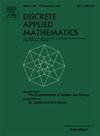Output-sensitive enumeration of maximal cliques in temporal graphs
IF 1
3区 数学
Q3 MATHEMATICS, APPLIED
引用次数: 0
Abstract
Community detection is one of the fundamental tasks in graph analysis, and cliques, representing a fully interconnected subset of nodes, are one of the archetypal models of community, typically focusing on those that are maximal under inclusion. Recent years witnessed an increase in prominence of temporal graphs, i.e., graphs where edges may freely appear and disappear. This scenario caused a wave of research devoted to understand the temporal structure, and how to adapt classical graph methods to this more complex model. Several adaptations have been proposed for cliques, as well as algorithms for finding maximal cliques. These, however, do not have output-sensitive guarantees, meaning considerable time could be spent to find a small number of solutions.
In this paper, we show how two different proposed models of temporal graphs, and the corresponding definitions of clique, are essentially equivalent, allowing us to consider a single model of clique without losing generality; furthermore, we develop an output-sensitive algorithm for finding all maximal cliques in the restricted scenario where each edge is present for a continuous interval: the algorithm runs in polynomial total time using polynomial space, or in incremental polynomial time if we allow exponential space usage.
While the restricted scenario limits the generality of the result, no output-sensitive algorithm for the problem exists as of yet, making this the first such result, and a first step into output-sensitive community detection in temporal graphs.
求助全文
约1分钟内获得全文
求助全文
来源期刊

Discrete Applied Mathematics
数学-应用数学
CiteScore
2.30
自引率
9.10%
发文量
422
审稿时长
4.5 months
期刊介绍:
The aim of Discrete Applied Mathematics is to bring together research papers in different areas of algorithmic and applicable discrete mathematics as well as applications of combinatorial mathematics to informatics and various areas of science and technology. Contributions presented to the journal can be research papers, short notes, surveys, and possibly research problems. The "Communications" section will be devoted to the fastest possible publication of recent research results that are checked and recommended for publication by a member of the Editorial Board. The journal will also publish a limited number of book announcements as well as proceedings of conferences. These proceedings will be fully refereed and adhere to the normal standards of the journal.
Potential authors are advised to view the journal and the open calls-for-papers of special issues before submitting their manuscripts. Only high-quality, original work that is within the scope of the journal or the targeted special issue will be considered.
 求助内容:
求助内容: 应助结果提醒方式:
应助结果提醒方式:


